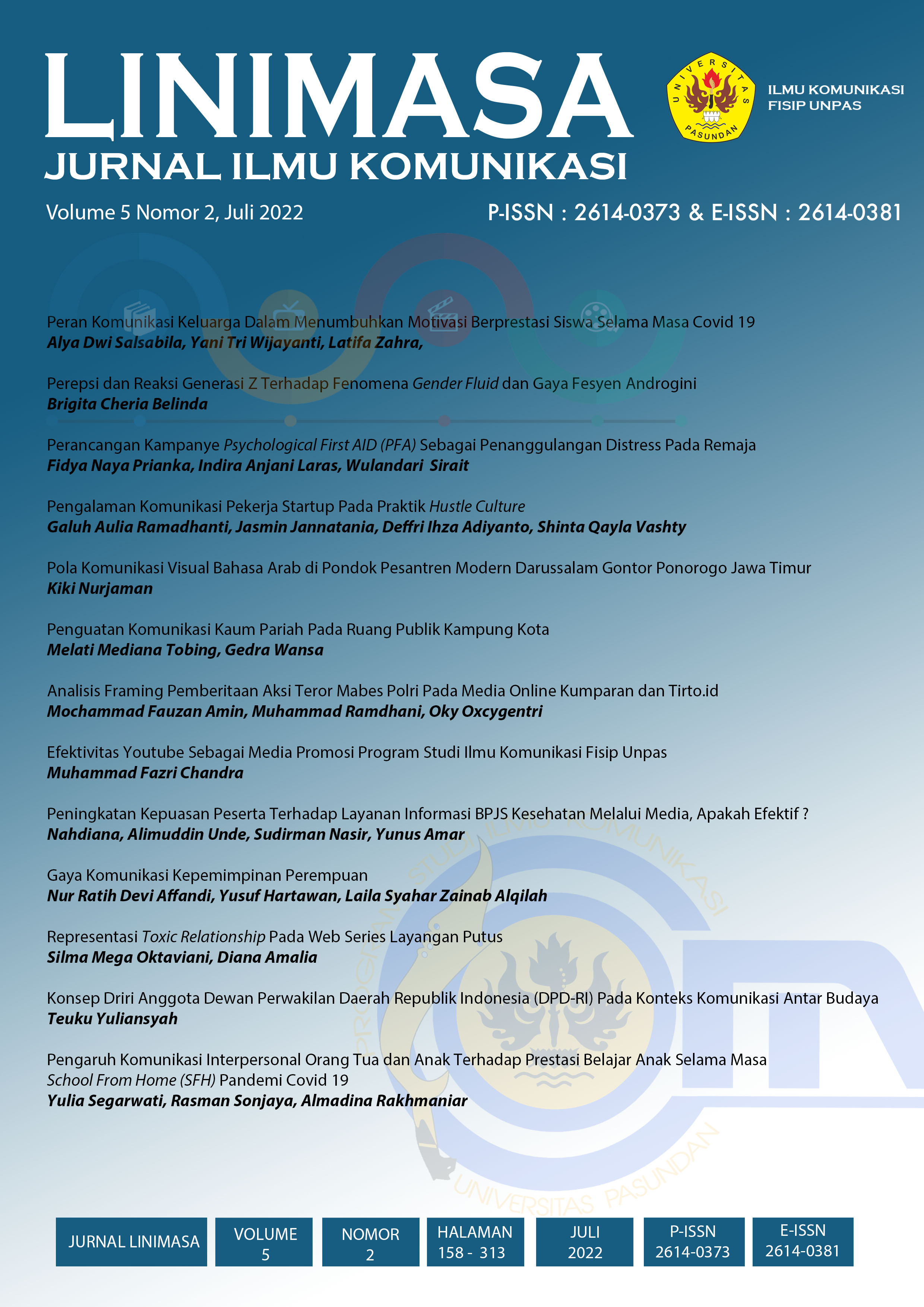PENINGKATAN KEPUASAN PESERTA TERHADAP LAYANAN INFORMASI BPJS KESEHATAN MELALUI MEDIA: APAKAH EFEKTIF?
DOI:
https://doi.org/10.23969/linimasa.v5i2.5192Abstract
Abstract Public Understanding of the National Health Insurance Program (JKN) is still lacking due to the limitations of health information services from the government. This study aims to find out whether the use of media in disseminating JKN Program information effectively provides information service satisfaction to BPJS Kesehatan participants. The study used a quantitative design with survey explanation methods. The population in this study was a non-PBI Health BPJS participant (not a Contribution Assistance Recipient) with a PPU category (Wage Earner Worker) of 405 people. Data retrieval techniques through questionnaires given to respondents through a google form. The data is processed using smart PLS and analyzed with the SEM (Structural Equation Model) approach. The results showed that the media had a positive and significant effect on participants' satisfaction which can be seen from the value of t-statistical media to satisfaction of 3.13 > 1.96 or p-value value of 0.00 < 0.05 and track coefficient value of 0.148 which indicates that the media aspect affects the media satisfaction of participants. Based on the results of the study, it can be concluded that the use of effective media provides satisfaction to BPJS Kesehatan participants. The results of this study are expected to be used as a consideration for BPJS Kesehatan to use more fragmented media to disseminate information taking into account the condition/ability of the community. Keywords: BPJS Health, information services, JKN Program, media, participant satisfactionDownloads
References
Daftar Pustaka
Agustina, R., Dartanto, T., Sitompul, R., Susiloretni, K. A., Suparmi, Achadi, E. L., Taher, A., Wirawan, F., Sungkar, S., Sudarmono, P., Shankar, A. H., Thabrany, H., Agustina, R., Dartanto, T., Sitompul, R., Susiloretni, K. A., Suparmi, Achadi, E. L., Taher, A., … Khusun, H. (2019). Universal health coverage in Indonesia: concept, progress, and challenges. The Lancet, 393(10166), 75–102. https://doi.org/10.1016/S0140-6736(18)31647-7
Andre, H., Dewi, A. K., Pangemanan, F., & Wang, G. (2019). Designing blockchain to minimize fraud in state-owned national insurance company (Bpjs kesehatan). International Journal of Emerging Trends in Engineering Research, 7(12), 794–797. https://doi.org/10.30534/ijeter/2019/117122019
Annisa, M. (2020). Analisis pengaruh penanganan komplain dan citra pelayanan terhadap kepuasan pasien situs online BPJS Kesehatan.
Arts, I., Fischer, A., Duckett, D., & van der Wal, R. (2021). Information technology and the optimisation of experience – The role of mobile devices and social media in human-nature interactions. Geoforum, 122, 55–62. https://doi.org/10.1016/j.geoforum.2021.03.009
Beaudoin, C. E., & Hong, T. (2021). Emotions in the time of coronavirus: Antecedents of digital and social media use among Millennials. Computers in Human Behavior, 123, 106876. https://doi.org/10.1016/j.chb.2021.106876
BPJS Kesehatan. (2020). Info BPJS Kesehatan ; JKN-KIS Jadi Bantalan Sosial Di Tengah Pandemi. Media Info BPJS Kesehatan, Edisi 92.
Cangara, H. (2019). Pengantar Ilmu Komunikasi. PT rajagrafindo Persada. https://www.rajagrafindo.co.id/produk/pengantar-ilmu-komunikasi/
Charoensukmongkol, P., & Sasatanun, P. (2017). Social media use for CRM and business performance satisfaction: The moderating roles of social skills and social media sales intensity. Asia Pacific Management Review, 22(1), 25–34. https://doi.org/10.1016/j.apmrv.2016.10.005
Chemouni, B. (2018). The political path to universal health coverage: Power, ideas and community-based health insurance in Rwanda. World Development, 106(August 2015), 87–98. https://doi.org/10.1016/j.worlddev.2018.01.023
Dartanto, T., Pramono, W., Lumbanraja, A. U., Siregar, C. H., Bintara, H., Sholihah, N. K., & Usman. (2020). Enrolment of informal sector workers in the National Health Insurance System in Indonesia: A qualitative study. Heliyon, 6(11), e05316. https://doi.org/10.1016/j.heliyon.2020.e05316
Fatema, K., & Lariscy, J. T. (2020). Mass media exposure and maternal healthcare utilization in South Asia. SSM - Population Health, 11, 100614. https://doi.org/10.1016/j.ssmph.2020.100614
Gita, A. (2020). Pelayanan informasi dengan kepuasan pasien.
Hair, J. F., Hult, G. T. M., Ringle, C. M., & Sarstedt, M. (2017). A Primer on Partial Least Squares Structural Equation Modeling (PLS-SEM). Thousand Oaks. Sage, 165.
Handayani, P. W., Meigasari, D. A., Pinem, A. A., Hidayanto, A. N., & Ayuningtyas, D. (2018). Critical success factors for mobile health implementation in Indonesia. Heliyon, 4(11), e00981. https://doi.org/10.1016/j.heliyon.2018.e00981
Handayani, P. W., Pinem, A. A., Azzahro, F., Hidayanto, A. N., & Ayuningtyas, D. (2019). The Information System/Information Technology (IS/IT) practices in the Indonesia health referral system. Informatics in Medicine Unlocked, 17(October). https://doi.org/10.1016/j.imu.2019.100263
Indonesiabaik.id. (2018). 66,3% masyarakat Indonesia Memiliki Smartphone | Indonesia Baik. In Indonesiabaik.id.
Juwito. (2008). Menulis Berita Dan Features. Unesa University Press, 149. http://eprints.upnjatim.ac.id/3071/2/Menulis_berita_dan_features_edit.pdf
Lavers, T. (2021). Aiming for Universal Health Coverage through insurance in Ethiopia: State infrastructural power and the challenge of enrolment. Social Science and Medicine, 282(September 2020), 114174. https://doi.org/10.1016/j.socscimed.2021.114174
Lee, J., Kim, K., Park, G., & Cha, N. (2021). The role of online news and social media in preventive action in times of infodemic from a social capital perspective: The case of the COVID-19 pandemic in South Korea. Telematics and Informatics, 64(March), 101691. https://doi.org/10.1016/j.tele.2021.101691
Maharani, C., Afief, D. F., Weber, D., Marx, M., & Loukanova, S. (2019). Primary care physicians’ satisfaction after health care reform: A cross-sectional study from two cities in Central Java, Indonesia. BMC Health Services Research, 19(1), 1–12. https://doi.org/10.1186/s12913-019-4121-2
Mahfud Sholihin, D. R. (2013). Analisis SEM-PLS dengan Warp PLS (Edisi 1 Ce). Andi Offset. https://digilib.unikom.ac.id/repo/sector/buku/view/1/key/21794/ANALISIS-SEM-PLS-dengan-Warp-PLS-3-0-untuk-Hubungan-Nonlinier-dalam-Penelitian-Sosial-dan-Bisnis.html
Nasution, S. K., Mahendradhata, Y., & Trisnantoro, L. (2020). Can a National Health Insurance Policy Increase Equity in the Utilization of Skilled Birth Attendants in Indonesia? A Secondary Analysis of the 2012 to 2016 National Socio-Economic Survey of Indonesia. Asia-Pacific Journal of Public Health, 32(1), 19–26. https://doi.org/10.1177/1010539519892394
Nugraha, Agus Ramdhani Lestrian, D. (2018). Sistem Informasi Geografis Data Kependudukan di Kelurahan Panglayungan Kecamatan Cipedes Kota Tasikmalaya. Jumantaka, 02(1), 81–90. http://jurnal.stmik-dci.ac.id/index.php/jumantaka/article/view/364
Pakurár, M., Haddad, H., Nagy, J., Popp, J., & Oláh, J. (2019). The service quality dimensions that affect customer satisfaction in the Jordanian banking sector. Sustainability (Switzerland), 11(4), 1–24. https://doi.org/10.3390/su11041113
Pusat Layanan Informasi BPJS Kesehatan. (2017). Panduan praktis tentang kepesertaan dan pelayanan kesehatan yang diselenggarakan oleh BPJS Kesehatan berdasarkan regulasi yang sudah terbit (BPJS Kesehatan (ed.)). Pusat layanan informasi BPJS Kesehatan.
Pusat Layanan Informasi BPJS Kesehatan. (2018). Panduan layanan bagi peserta JKN-KIS. In BPJS (Vol. 1). https://doi.org/10.21831/dinamika.v5i1.31001
Pynnönen, S., Haltia, E., & Hujala, T. (2021). Digital forest information platform as service innovation: Finnish Metsaan.fi service use, users and utilisation. Forest Policy and Economics, 125(June 2020). https://doi.org/10.1016/j.forpol.2021.102404
Riyanto, R. (2017). Efektivitas Media Internet Terhadap Kepuasan Khalayak Media. InterKomunika, 2(1), 61. https://doi.org/10.33376/ik.v2i1.16
Rossza, D. A. (2020). Pengaruh Media Sosial Instagram @halodoc Terhadap Pemenuhan Kebutuhan Informasi Kesehatan Followers. Jom Fisip, 7(I), 1–11.
Rusho, M. A., Ahmed, M. A., & Sadri, A. M. (2021). Social media response and crisis communications in active shootings during COVID-19 pandemic. Transportation Research Interdisciplinary Perspectives, 11, 100420. https://doi.org/10.1016/j.trip.2021.100420
Sailer, M., Murböck, J., & Fischer, F. (2021). Digital learning in schools: What does it take beyond digital technology? Teaching and Teacher Education, 103. https://doi.org/10.1016/j.tate.2021.103346
Supadiyanto. (2020). Media, komunikasi, dan krisis covid-19 (A. Muntaha (ed.)).
Tjiptono, F. (2019). Kepuasan Pelanggan (A. Diana (ed.); Edisi 1).
Waluyo, S. (2020). Analysis of Public Interest on The participation of BPJS at Health Facility of First Level in Puskesmas Kebaman Banyuwangi 2018. Journal for Quality in Public Health, 3(2), 329–333. https://doi.org/10.30994/jqph.v3i2.80
Wang, G., Alatas, S., & Wiraniagara, A. (2019). Factors affecting acceptance of mobile health insurance in Indonesia: TAM applicability. International Journal of Advanced Trends in Computer Science and Engineering, 8(6), 3004–3011. https://doi.org/10.30534/ijatcse/2019/54862019
Weretecki, P., Greve, G., Bates, K., & Henseler, J. (2021). Information management can’t be all fun and games, can it? How gamified experiences foster information exchange in multi-actor service ecosystems. International Journal of Information Management, 61(July). https://doi.org/10.1016/j.ijinfomgt.2021.102391
Winarni, N., & Lestari, R. D. (2019). Netizen News Sources in the Journalistic Ethics Perspective (Case Study in Online Media Jogja.tribunnews.com). Journal Pekommas, 4(1), 85. https://doi.org/10.30818/jpkm.2019.2040109













